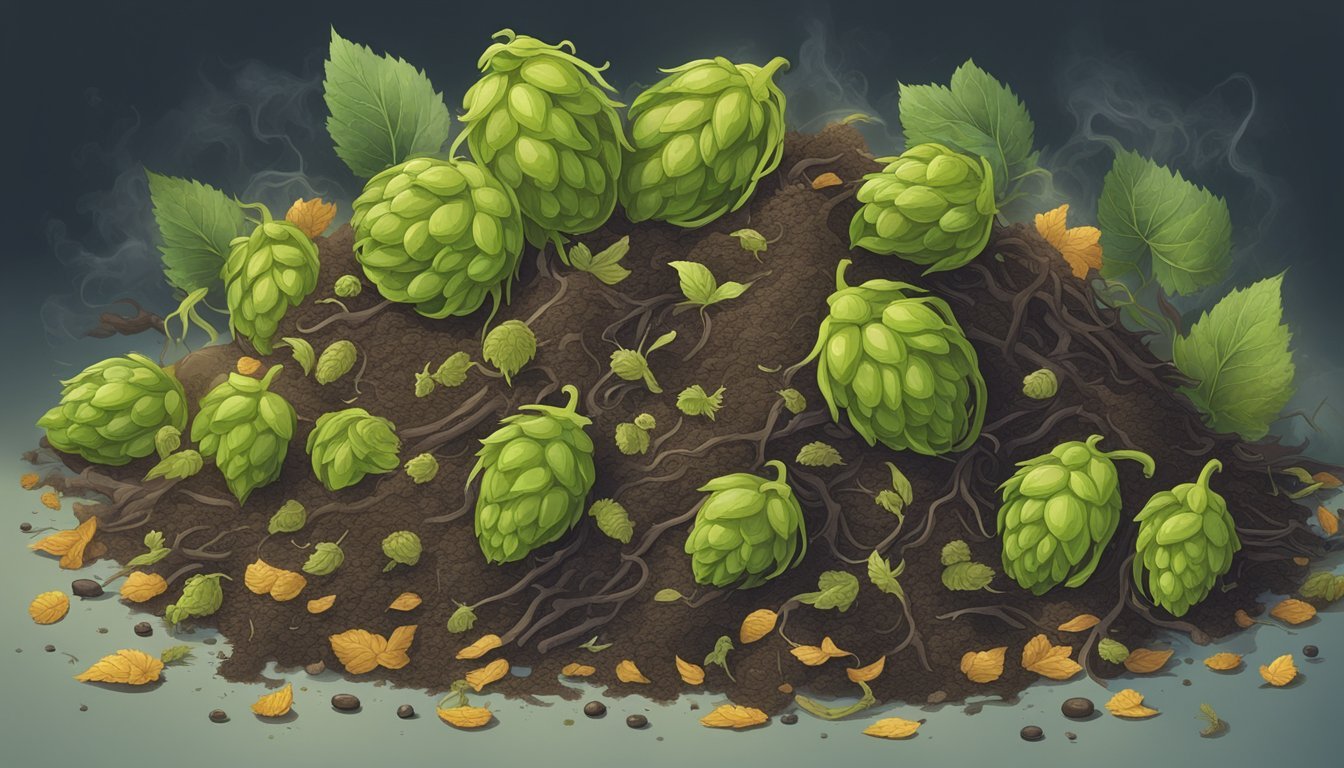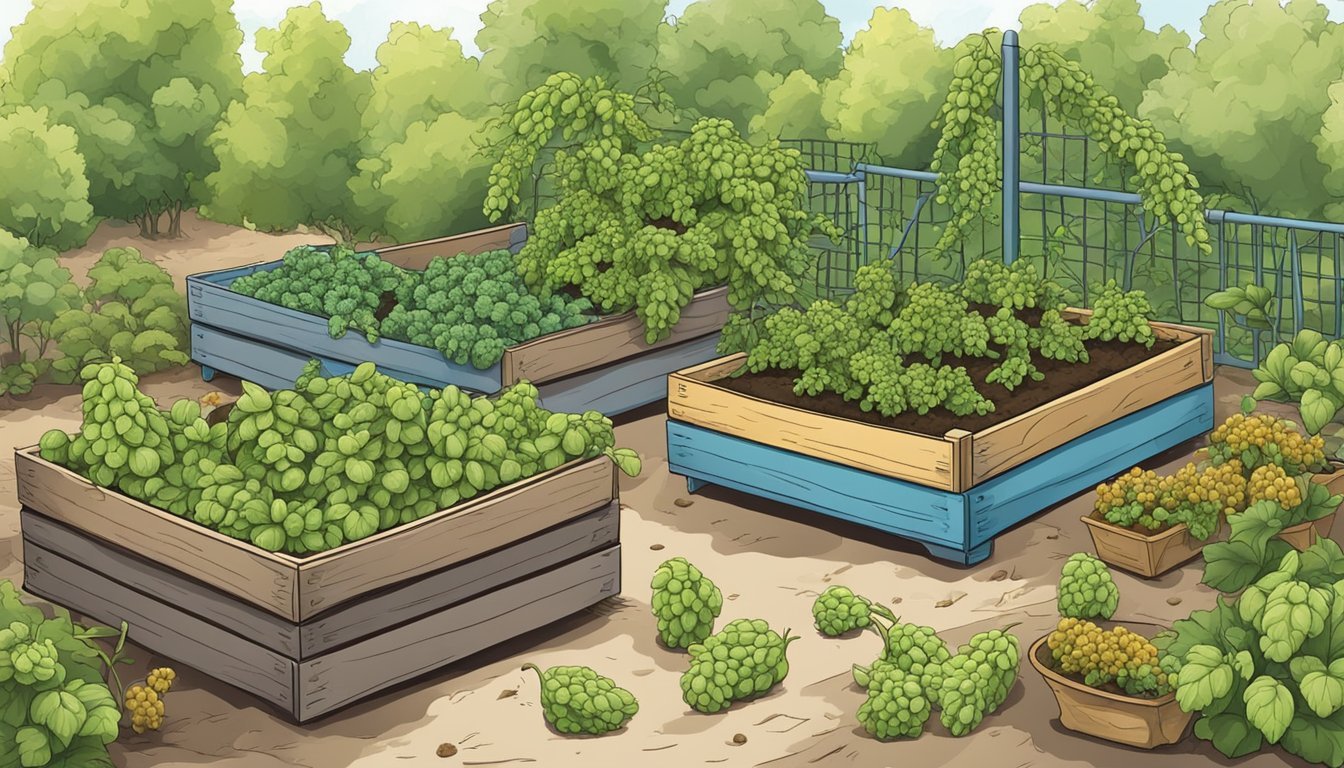Can You Compost Hops?
Understanding Their Role in Composting Systems
Hops are commonly known for their role in beer brewing, providing the characteristic bitter flavor and aroma to many varieties of beer. However, beyond their use in brewing, hops have a place in the sustainable practice of composting. Composting spent hops can significantly benefit garden soil, mainly due to their rich nitrogen content. These nitrogen-rich materials are considered "green" compost matter and help create a balanced compost which is crucial for plant growth.
In any garden, compost serves as a nutrient-rich soil amendment, promoting soil health and fertility. Hops, when added to a compost pile, decompose like other green materials, such as vegetable scraps or grass clippings. The process of composting hops requires attention to balance, as with any composting efforts, ensuring that a diversity of materials creates the ideal environment for decomposition and subsequent soil enrichment.
While hops are an excellent addition to a compost pile, it is important to consider safety, particularly for pet owners. Certain spent hop varieties can be toxic to dogs if ingested. Gardeners with pets should either secure their compost heaps or consider alternative methods for disposing of spent hops to prevent any risk to their animals.
Benefits of Composting Hops
Composting hops enriches the garden soil with essential nutrients and supports sustainable gardening practices. It is particularly beneficial for homebrewers and garden enthusiasts who seek eco-friendly waste management solutions.
Nutrient Contribution to Soil
Hops add significant value to compost as they are rich in nitrogen, which is a vital nutrient for healthy plant growth. When hops decompose, they release this nitrogen, along with other nutrients such as phosphates and potassium, contributing to a nutrient-dense organic matter that enhances soil fertility.
Natural Gardening Practices
Incorporating hop plants into compost reflects a commitment to natural gardening practices. It reduces the need for synthetic fertilizers, allowing gardeners to manage their gardens more organically. Composted hops serve as an excellent natural mulch, helping to suppress weeds while retaining soil moisture.
Enhancing Plant Growth
Hops in compost act as a growth stimulant for garden plants. The rich organic matter provided by hop compost improves soil structure, which increases the soil's ability to hold water and nutrients. This results in stronger, healthier plants with enhanced resistance to pests and diseases.
Eco-Friendly Waste Management
By composting spent hops, gardeners and brewers turn potential waste into a resource. This eco-friendly waste management strategy reduces landfill contributions while producing valuable compost for the garden, closing the loop in a sustainable cycle.
Sustainability in Brewing
For homebrewers and breweries, composting spent hops aligns with sustainable brewing practices. It allows them to repurpose by-products of the brewing process, reducing their environmental footprint and contributing positively to the ecosystem.
Improving Garden Ecology
The addition of hops to a compost pile encourages diverse microbial activity, which is essential for breaking down organic matter into fertile compost. This microbial action results in a robust garden ecology, promoting the growth of beneficial organisms that enhance soil health and plant growth.
Understanding Hops
Hops are integral to the brewing industry, prized for their flavor and preservation qualities in beer. This section delves into their biological structure, diverse varieties, and growth requirements.
Anatomy of Hop Plants
Hop plants, or Humulus lupulus, are known for their distinctive bines that climb and twine, which can grow up to 25 feet in a single season. The bines have stiff hairs that aid in climbing, and they grow from the crown, a perennial organ that remains underground. The most valued parts of the hop plant are the cones, which contain the lupulin glands; these glands house the alpha acids and essential oils responsible for the aroma and bitterness in beer.
Varieties and Their Characteristics
The many varieties of hop plants have unique profiles of flavor and aroma, which contribute differently to beer. For example, Chinook is known for its spicy and piney qualities, Cascade for its floral and citrus notes, and Centennial often cited as a balanced all-rounder. Willamette is typically milder and used for its pleasant aroma rather than bitterness.
Hop Plants' Life Cycle
Hop plants are perennial, emerging from their rhizomes in spring. The growth rapidly accelerates, often at a rate of a foot per day under optimal conditions. Post the vegetative phase, female plants produce cones which are harvested in late summer to early autumn. Following harvest, the bines die back to the crown, which goes dormant during winter.
Optimal Conditions for Growing Hops
Ideal conditions for growing hops include deep, well-drained soil and a location with full sunlight. Hops thrive in a climate that has a dormant cold season, which is essential for the rhizomes' rest period. Soil preparation should ensure plenty of organic matter, and a pH between 6.0-7.5 is generally recommended.
Sexual Dimorphism in Hops
Hops are dioecious, meaning there are distinct male and female plants. It is the female plants that are cultivated in gardens for brewing, as they produce the cones that contain the valuable alpha acids and oils. Male plants are typically only needed for breeding programs, as they do not contribute to the yield of cones.
Composting Process
The composting process effectively recycles spent hops and other organic matter into a nutritionally rich soil amendment, ideal for supporting robust plant growth. It requires careful management of materials, moisture, and aeration to produce quality compost.
Building the Compost Pile
A compost pile begins with alternating layers of carbon-rich materials, such as dried leaves, and nitrogen-rich substances, like kitchen scraps or spent hops. A ratio of about 3:1 of carbon to nitrogen provides a balanced environment for microbes to thrive.
Balancing Compost Ingredients
To maintain a healthy compost, a balance between green materials (nitrogen) and browns (carbon) is necessary. Green materials include grass clippings and spent hops, which are particularly nitrogen-rich. Browns can be leaves, straw, or wood chips. This balance aids in odor management and accelerates decomposition.
Caring for the Compost Pile
Regularly watering the pile to maintain consistent moisture, similar to the feel of a wrung-out sponge, is key. Aeration through turning the pile ensures oxygen reaches the microbes. Adequate sun exposure aids in heating the pile, driving the thermophilic decomposition phase.
Composting Hops After Harvest
After harvest, spent hops can be added to the compost. They decompose well given their high nitrogen content. Fresh or dried hops should be mixed with carbonaceous materials to avoid a dense, wet layer that could lead to odor issues or slow breakdown.
Troubleshooting Common Issues
Common issues like odors, pests, or improper decomposition often stem from lack of air circulation, too much moisture, or imbalance between green and brown materials. Adjusting the pile by adding more browns, turning it, or regulating moisture can resolve these issues.
Using Compost in the Garden
Once matured, compost acts as a potent fertilizer and soil conditioner. It can improve soil structure, water retention, and provide essential nutrients. Compost should be spread as mulch around plants or worked into the garden soil.
Key Composting Practices for Hop Growers
For hop growers, composting represents a sustainable method to manage organic waste and return nutrients to the soil. *Spent hops, in particular, are valuable for their nitrogen content. However, maintaining a diverse mix in the compost pile is critical for balanced nutrient content and efficient decomposition.
Care and Maintenance of Hop Plants
Proper care and maintenance of hop plants are crucial for a healthy and productive hop garden. Essential practices include appropriate planting, robust trellis support, regular watering and nutrient management, thorough pruning, and vigilant pest and disease control.
Planting and Spacing
Hop plants thrive in a location with full sun and well-draining soil. For successful cultivation, plant rhizomes in early spring after the threat of frost has passed. Space hop plants about 2-3 feet apart within rows and 8 feet between rows to ensure adequate air circulation and sunlight penetration.
Trellising and Support
A sturdy trellis or support system is necessary for the vertical growth of hop bines. Trellises should stand 12 to 20 feet high to accommodate the plant’s inclination to climb. Training the bines involves gently wrapping them around the support strings or wires in a clockwise direction as they grow.
Watering and Nutrient Management
Hop plants require consistent watering, especially during dry spells, without becoming waterlogged. Provide hop plants with a balanced fertilizer containing nitrogen, phosphorus, and potassium throughout the growing season, applying it when growth begins in spring and at 4 to 6-week intervals thereafter.
Pruning and Managing Growth
In spring, select only the strongest bines for training and prune away the others to focus the plant's energy. Throughout the season, periodic pruning of the lower leaves up to 2-3 feet from the ground will improve air circulation and minimize disease risk.
Dealing with Pests and Diseases
Common pests such as spider mites, aphids, and Japanese beetles, along with diseases like downy mildew (Pseudoperonospora humuli) and powdery mildew, can affect hop plants. Regularly inspect plants and implement organic or chemical controls, if necessary, to manage these threats. Prevention includes proper spacing, air circulation, and avoiding wetting foliage during irrigation to reduce disease incidence.
Harvesting and Utilization of Hops
In cultivating hops, timing and techniques are crucial in harvesting for optimal flavor and aroma in brewing, whereas post-harvest handling ensures longevity and utility. Spent hops also find their place in garden composting, enriching the soil.
Determining Harvest Time
Determining the right time to harvest hops is essential for quality yield. They are typically ready when the hop cones are papery, light in weight, and emit a strong aroma. The lupulin glands should be visible and yellow when the cones are opened. Hops generally reach maturity between late summer and early fall.
Methods of Harvesting Hops
Harvesting can be done by hand or mechanically. For small-scale growers and homebrewers, hand-picking is common, which involves carefully removing the hop cones from the bines. On commercial farms, mechanical harvesters strip the cones and bines from the plants.
Processing and Storing Hops
Once harvested, hops must be dried to a moisture content of around 8-10% to prevent mold and preserve flavor. They can be laid out on screens in a cool, dry location or dried using a food dehydrator. Properly dried hops are then typically vacuum-sealed and stored in a refrigerator or freezer.
Using Harvested Hops in Homebrewing
Freshly harvested or dried hops are a key ingredient in homebrewing beer, contributing to bitterness, aroma, and flavor. They are used in different stages of brewing, such as boiling for bitterness or as a "dry-hop" addition to impart aroma. Common beer styles utilizing hops include IPA and Pale Ale.
Other Uses for Hops in and out of the Garden
Hops are not only for brewing; they can be mulched for garden use or added to salads for their flavor. Their climbing vines can also offer shade and decorative greenery when grown in full sun.
Disposing of Spent Hops
Post-brewing, spent hops are nitrogen-rich and an excellent green material for composting. They can be added to a compost pile along with other compostable materials to create a balanced and nutrient-rich soil amendment for gardening enthusiasts.




